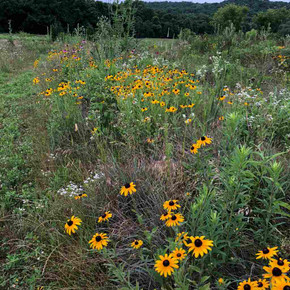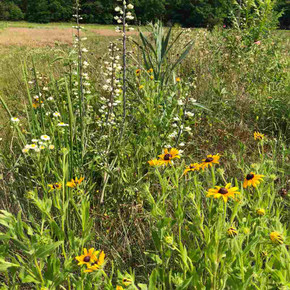
Rudbeckia fulgida var. sulivantii 'Goldsturm' - BLACK-EYED SUSAN 'GOLDSTURM' (rough look, spreading & groundcovering)
If there is a true perennial classic, it has to be Rudbeckia ‘Goldsturm‘. This striking cultivar has been popular in horticulture since its introduction in 1949, and its popularity was crowned by the Award of Garden Merit by Royal Horticultural Society in 1993; it was also selected by the Perennial Plant Association as the 1999 Perennial Plant of the Year.
Here are the highlights of this variety: it has compact growth and good texture, a very long blooming period of nearly 3 months (each single flower blooms for 2 weeks and is about 2" across), ornamental seed heads, nearly 100% flower coverage of the mounds, is adaptable and drought tolerant, easy to grow and low maintenance, a quite long-lived perennial, good pollinator plant, black walnut tolerant, a long lasting cut flower and quite good groundcover for full sun...it's simply an exceptional herbaceous plant!
What makes my heart really happy is writing about its historic background, because this superb cultivar was discovered in my home country of Czechoslovakia in 1937, during the difficult years caused by WWII; it came to the market in 1949, after the war was over.
The seeds of the wild form were originally shipped from the USA to The Botanical Garden of the University in Graz (Germany) and given to The Brother Schütz Nursery in Czechoslovakia (Gebrüder Schütz). The Nursery of Brother Schütz (located in Olomučany at Blansko) was well-established at that time and a recognized perennial nursery with central European connections.
In this nursery began the career of Heinrich Hagemann, who became head gardener for world famous perennial breeder and grower Karl Foerster. While Hagemann was on a private visit to this nursery, he noticed and admired the compact habit and floods of blooms of this floriferous charmer, which had already been cultivated in the experimental flower beds of the so-called ”Gethsemane garden“.
Heinrich brought some plants back to Potsdam, Germany in 1937 and, along with Karl Foerster, began to grow and propagate them. Legend says that upon seeing the flowers for the first time in 1938, Karl Foerster called out 'Goldsturm!' (= 'Gold Storm')
Since then, the bright golden-yellow flowers of 'Goldsturm' have shone in gardens worldwide.
(The Czechoslovakian Brother Schütz Nursery is also connected to architect Grete Roder Müller, co-creator of the garden of Villa Tugendhat, a work of unique/pioneer modern European architecture in Brno, Czech Republic. Heinrich Hagemann started his own nursery, Hagemann Staudenkulturen, that still operates to this day.)
Rudbeckia ‘Goldsturm‘ fits into any sunny border with medium-moist to medium-dry soil. Great in any landscaping – private and public spaces, cottage gardens, woodland edges, butterfly gardens, pollinator gardens, plantings supporting birds. The number of suitable companions is never-ending. The best contrast of yellow- blue combinations can be achieved by adding Agastache ‘Blue Fortune‘, Agastache ‘Black Adder‘ or Agastache ‘Blue Boa‘, Aster frikartii ‘Monch‘, Aster oblongifolius, Aster novae-angliae – bluish cultivars, Delphinium (with second re-blooms), Echinops, Eryngium planum, Geranium ‘Rozanne‘ and it’s descentants, Lobelia siphilitica (on moist soils), Monarda ‘Blue Stoking‘, Nepeta x faasenii (if it was cut back previously), Perovskia, Phlox paniculata ‘Blue Paradise‘, Salvia farinacea, Verbena bonariensis, Verbena hastata ‘Blue Spires‘ or with blue flowering shrubs of Hydrangea macrophylla in the background.
Other great combos are with Coreopsis, Echinacea purpurea, Eupatorium, Gaura, Helenium, reblooming Hemerocallis, Monarda, Persicaria amplexicaulis, Physostegia, Sedum telephium and grasses like Panicum virgatum, Schizachyrium scoparium, Sporobolus heterolepis, Stipa or species of Hydrangea.
In spaces without enough air circulation, some leaf fungi diseases (septoria leaf spot) or powdery mildew can occur. If ‘Goldsturm‘ really suffers in some locations, you can replace it with a new variety of Rudbeckia, ‘American Gold Rush,‘ which is fungus & disease free!
Blooming Time: June to September
Size: usually 2-2.5’ tall x 18-24” wide (spacing about 12-15"), it spreads slowly on the soil surface by shorter rhizomes; the leaves provide some groundcover
USDA Zones: 4 to 8
Culture: full sun, half sun, half shade (flowers less there), average garden soil, moist, well-drained soils, loamy soils, clayish soils. Adaptable to sandy or rocky soil if they are not too dry.
Moisture Needs: medium-dry, medium, medium-moist, moist, quite drought tolerant once established
Origin: garden origin, seed line. The wild form of Rudbeckia fulgida var. sullivantii is native in areas from New York to West Virginia and west to Michigan, Illinois, Missouri and Arkansas. Can be found in swamps, shorelines, fens and sedge meadows. The wild form is not commonly sold because of the extreme popularity of its ornamentally-upscale cultivar ‘Goldsturm’.
Deer/Rabbit Resistant: yes / yes, but some mammals can browse the leaves
Attracts Butterflies or Pollinators: flowers offer nectar and pollen to butterflies, native bees, honey bees, pollinating flies, skippers and beetles. Caterpillars of several moths feed on the foliage and flowers. Songbirds feed on the seeds.
Attracts Hummingbirds: no
Pot Size: 3.5" x 5" perennial pot (1.22 pt/580 ml)

Rudbeckia fulgida var. sulivantii 'Goldsturm' - BLACK-EYED SUSAN 'GOLDSTURM' (rough look, spreading & groundcovering)
If there is a true perennial classic, it has to be Rudbeckia ‘Goldsturm‘. This striking cultivar has been popular in horticulture since its introduction in 1949, and its popularity was crowned by the Award of Garden Merit by Royal Horticultural Society in 1993; it was also selected by the Perennial Plant Association as the 1999 Perennial Plant of the Year.
Here are the highlights of this variety: it has compact growth and good texture, a very long blooming period of nearly 3 months (each single flower blooms for 2 weeks and is about 2" across), ornamental seed heads, nearly 100% flower coverage of the mounds, is adaptable and drought tolerant, easy to grow and low maintenance, a quite long-lived perennial, good pollinator plant, black walnut tolerant, a long lasting cut flower and quite good groundcover for full sun...it's simply an exceptional herbaceous plant!
What makes my heart really happy is writing about its historic background, because this superb cultivar was discovered in my home country of Czechoslovakia in 1937, during the difficult years caused by WWII; it came to the market in 1949, after the war was over.
The seeds of the wild form were originally shipped from the USA to The Botanical Garden of the University in Graz (Germany) and given to The Brother Schütz Nursery in Czechoslovakia (Gebrüder Schütz). The Nursery of Brother Schütz (located in Olomučany at Blansko) was well-established at that time and a recognized perennial nursery with central European connections.
In this nursery began the career of Heinrich Hagemann, who became head gardener for world famous perennial breeder and grower Karl Foerster. While Hagemann was on a private visit to this nursery, he noticed and admired the compact habit and floods of blooms of this floriferous charmer, which had already been cultivated in the experimental flower beds of the so-called ”Gethsemane garden“.
Heinrich brought some plants back to Potsdam, Germany in 1937 and, along with Karl Foerster, began to grow and propagate them. Legend says that upon seeing the flowers for the first time in 1938, Karl Foerster called out 'Goldsturm!' (= 'Gold Storm')
Since then, the bright golden-yellow flowers of 'Goldsturm' have shone in gardens worldwide.
(The Czechoslovakian Brother Schütz Nursery is also connected to architect Grete Roder Müller, co-creator of the garden of Villa Tugendhat, a work of unique/pioneer modern European architecture in Brno, Czech Republic. Heinrich Hagemann started his own nursery, Hagemann Staudenkulturen, that still operates to this day.)
Rudbeckia ‘Goldsturm‘ fits into any sunny border with medium-moist to medium-dry soil. Great in any landscaping – private and public spaces, cottage gardens, woodland edges, butterfly gardens, pollinator gardens, plantings supporting birds. The number of suitable companions is never-ending. The best contrast of yellow- blue combinations can be achieved by adding Agastache ‘Blue Fortune‘, Agastache ‘Black Adder‘ or Agastache ‘Blue Boa‘, Aster frikartii ‘Monch‘, Aster oblongifolius, Aster novae-angliae – bluish cultivars, Delphinium (with second re-blooms), Echinops, Eryngium planum, Geranium ‘Rozanne‘ and it’s descentants, Lobelia siphilitica (on moist soils), Monarda ‘Blue Stoking‘, Nepeta x faasenii (if it was cut back previously), Perovskia, Phlox paniculata ‘Blue Paradise‘, Salvia farinacea, Verbena bonariensis, Verbena hastata ‘Blue Spires‘ or with blue flowering shrubs of Hydrangea macrophylla in the background.
Other great combos are with Coreopsis, Echinacea purpurea, Eupatorium, Gaura, Helenium, reblooming Hemerocallis, Monarda, Persicaria amplexicaulis, Physostegia, Sedum telephium and grasses like Panicum virgatum, Schizachyrium scoparium, Sporobolus heterolepis, Stipa or species of Hydrangea.
In spaces without enough air circulation, some leaf fungi diseases (septoria leaf spot) or powdery mildew can occur. If ‘Goldsturm‘ really suffers in some locations, you can replace it with a new variety of Rudbeckia, ‘American Gold Rush,‘ which is fungus & disease free!
Blooming Time: June to September
Size: usually 2-2.5’ tall x 18-24” wide (spacing about 12-15"), it spreads slowly on the soil surface by shorter rhizomes; the leaves provide some groundcover
USDA Zones: 4 to 8
Culture: full sun, half sun, half shade (flowers less there), average garden soil, moist, well-drained soils, loamy soils, clayish soils. Adaptable to sandy or rocky soil if they are not too dry.
Moisture Needs: medium-dry, medium, medium-moist, moist, quite drought tolerant once established
Origin: garden origin, seed line. The wild form of Rudbeckia fulgida var. sullivantii is native in areas from New York to West Virginia and west to Michigan, Illinois, Missouri and Arkansas. Can be found in swamps, shorelines, fens and sedge meadows. The wild form is not commonly sold because of the extreme popularity of its ornamentally-upscale cultivar ‘Goldsturm’.
Deer/Rabbit Resistant: yes / yes, but some mammals can browse the leaves
Attracts Butterflies or Pollinators: flowers offer nectar and pollen to butterflies, native bees, honey bees, pollinating flies, skippers and beetles. Caterpillars of several moths feed on the foliage and flowers. Songbirds feed on the seeds.
Attracts Hummingbirds: no
Pot Size: 3.5" x 5" perennial pot (1.22 pt/580 ml)
Customer Reviews
-
Rudbeckia
REVIEW: I ordered two rudbeckias. After opening the box, all looked well. I followed the instructions but one of the plants wilted a day after receiving my order. I planted it and watered it but it still looks wilted and dead. The rest of my order is doing fine in my garden. REPLY: Hello Kerra, Thank you for taking the time to leave a review! We're sorry to hear that one of your Rudbeckia 'Goldsturm' plants is not doing well. We will send you a replacement plant at the beginning of next week! Thanks again, USP
-
Black Eyed Susan
Plant arrived well packed, watered ready for planting. Great purchase and would definitely recommend US Perennials!!
-
Black-Eyed Susan Goldsturm
We ordered a fair sized group of 7 different types of plants. All of the plants came to us well packaged and were shipped to us quite quickly. All of the plants arrived in good shape and they are now thriving in our garden.





